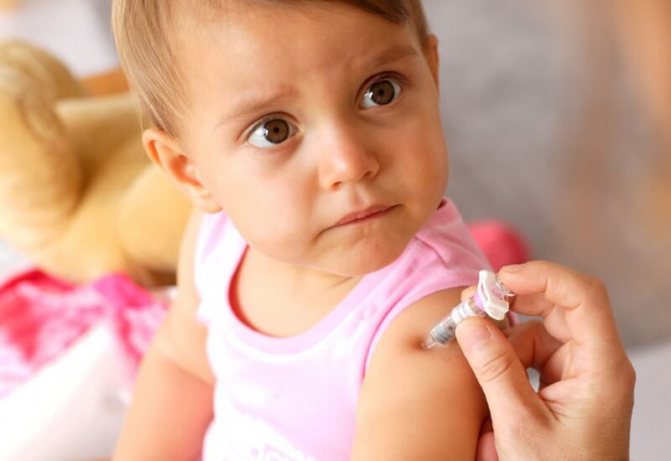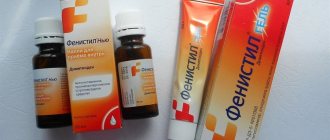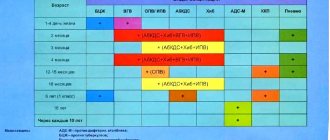When should I get tested for children before IgE vaccination (ImmunoCAP)?
– a study on the eve of vaccination in children with a predisposition to allergies; – adverse events after vaccination that occurred within a period of no more than a month before the study.
If more time has passed since vaccination, the result may be negative. A more sensitive method for determining an allergic reaction associated with vaccination, in this case, is skin allergy testing. The Gemotest laboratory does not perform allergy tests; to conduct this study, you must consult an allergist.
Pentaxim
All components of Pentaxim are included in the National Preventive Vaccination Calendar; it is considered one of the main vaccines. It is administered three times - in the first year of life and a fourth time - a year after the third dose. If age (in addition to Pentaxim) requires the introduction of a vaccine against hepatitis B, the doctor may suggest replacing Pentaxim with Infanrix Hexa. In addition to components identical to Pentaxim, this drug additionally contains a vaccine against hepatitis B.
Pentaxim contains five components and protects the child from the following diseases:
- whooping cough - paroxysmal, hacking, extremely intense cough (to the point of respiratory arrest, vomiting, rib fractures), lasting 3-5 months in a row; in the first six months of a child’s life it can be deadly, transmitted by airborne droplets from patients or carriers;
- diphtheria - dangerous deposits of films in the throat that can block breathing (true croup), in the later stages the disease can lead to damage to the heart muscle and other complications, many of them are fatal; transmitted by airborne droplets from patients or carriers;
- tetanus - muscle spasms and convulsions, first local and then generalized, in all muscles at the same time (opisthotonus), leading to bone fractures and fatal respiratory failure; transmitted through infected wounds of the skin and mucous membranes, especially if part of the wound does not have access to air (for example, when the foot is wounded with a rusty nail);
- polio - fever, headache, sore throat and paralysis;
- infections caused by Haemophilus influenzae type b - meningitis, pneumonia, otitis, epiglottitis.
Combining several drugs in one is an absolute advantage of Pentaxim, since it reduces the number of injections that a child needs to administer.
Pentaxim differs from Russian vaccines primarily in its acellular pertussis component (Russian pertussis vaccines are whole cell), which ensures its good tolerability.
If the vaccine has not been administered within the time frame recommended by the NCPP, it is administered at the age of request for vaccination, also four times, with a minimum interval of 1 month between the first three doses and an interval of 6 months between the third and fourth dose. If one or more doses were previously administered and then followed by a long interval, restarting the vaccine series is not required, but the missing doses must be administered as soon as possible, observing the minimum intervals between them.
The Pentaxim vaccine is not administered earlier than 2 months and later than 7 years of age.
Tolerability of the vaccine is average: in the evening after vaccination, approximately every tenth child may feel unwell, the temperature may rise to 38 °C, and the injection site may be slightly sore. Around one in 20 people may experience a fever of up to 39°C, severe redness and swelling at the injection site, and malaise. These reactions are safe , resolve within 1–3 days and require only paracetamol or Nurofen to relieve symptoms. The vaccine contains no live components, so there are no delayed adverse reactions to it.
Vaccination calendar for children from 0 to 7 years old
Graphic calendar of vaccinations for children from birth to 7 years of age, indicating the timing of vaccine administration according to Russian rules. Source:
CDC calendar
Editorial team:
pediatrician Sergei Butriy
Detailed description of the study
Allergies occur when the immune system reacts abnormally to proteins entering the body. Immune cells perceive them as foreign antigens and cause a special inflammatory reaction, accompanied by vasodilation and tissue swelling under the influence of the chemically active substance histamine.
Proteins to which such a reaction occurs are called allergens. Specific immunoglobulins are formed for them - IgE, which form a compound with these proteins and promote their removal from the body. This is similar to how the immune system fights infectious agents.
The first encounter with an allergen is often asymptomatic, but leads to the formation of IgE aimed at combining with the protein, and repeated contact with it leads to the development of an allergic reaction. The following symptoms often develop:
- nasal congestion; – runny nose with clear discharge; – lacrimation; – burning in the eyes; – sneezing; – dry cough; - urticaria-type rashes.
Allergies to a particular protein most often occur in childhood, and in some cases disappear with adulthood. A predisposition to allergic reactions can be inherited, but is sometimes detected in people whose family has never suffered from such diseases.
Given the existence of many allergens, it is important to promptly identify the cause of the allergy. The ImmunoCAP method allows you to determine the presence of antibodies to allergen proteins with high accuracy even in a small volume of blood serum. The test results are not affected by drug therapy, which is extremely important for people who cannot stop taking it.
Sometimes the development of an allergic reaction is observed after vaccination. In most cases, this problem is caused by components of the vaccine and not by the immunizing agent itself.
Substances in vaccines that can cause allergic reactions include gelatin or egg whites, baker's yeast, formaldehyde and thimerosal, and latex contained in vial stoppers or syringe plungers. Administration of the first of a series of necessary vaccines to children can lead to sensitization of the body to these substances, which subsequently causes the development of an allergic reaction.
Diagnosis of allergy or sensitization to vaccine components is aimed at preparing for vaccination of children who suffer from allergies. For this purpose, the ImmunoCAP method is used, which serves as a reliable way to determine the cause of allergic reactions. The information obtained allows you to predict the risk of complications after vaccine administration and draw up an individual vaccination plan.
Is it possible to get Pentaxim and hepatitis vaccinations on the same day at the same time?
Pentaxim and hepatitis B vaccinations are given to protect the body from the pathogens of tetanus, diphtheria, polio, whooping cough, Haemophilus influenzae infection and hepatitis virus.
A person who has not received vaccines against these pathologies has a high risk of infection. If the disease develops, it will be difficult to avoid negative consequences. Parents often wonder whether it is possible to combine Pentaxim and vaccination against hepatitis type B. There are no strict prohibitions in the instructions on vaccination with two drugs on the same day.
Many doctors advocate simultaneous immunization against hepatitis B, tetanus, polio, whooping cough, hemophilus influenzae and diphtheria. If, according to health conditions, the Pentaxim injection was not given on time, and the hepatitis B vaccine is next in line according to the plan, then the pediatrician may recommend that parents combine these vaccinations and immunize on the same day.
Injection solutions are administered intramuscularly, do not suppress each other’s effects and do not provoke the development of severe adverse reactions. When combining two drugs, it is important to maintain a certain interval of 45 days after the previous vaccine.

Vaccine Pentaxim
If the mother brought the child to the clinic when it is time to get one vaccination, and the second one should be given on schedule in a couple of weeks, then the doctor can reschedule the immunization until the date of the second prophylaxis. It is prohibited to vaccinate before the set date, but giving an injection a little later is allowed.
Judging by the reviews of parents, the simultaneous use of Pentaxim and vaccination against hepatitis B does not lead to bad consequences: the child feels normal, he does not develop a fever or allergies. Therefore, if the doctor advises immunization with two drugs on the same day, you should not refuse.
For good tolerability of Pentaxim and the vaccine against hepatitis type B, the pediatrician may recommend taking Fenistil. This medication reduces the likelihood of developing allergic reactions. The medicine should be taken several days before and after immunoprophylaxis.
Features of the Pentaxim composition
The Pentaxim vaccine helps protect the human body from five infectious diseases at once - Haemophilus influenzae infection, which causes a number of serious diseases (meningitis, pneumonia, purulent otitis media and others), tetanus, diphtheria, polio and whooping cough. It contains components such as pertussis, tetanus and diphtheria, inactivated polio virus, as well as filamentous hemagglutinin.
Content:
- Features of the Pentaxim composition
- When to do and how to prepare for vaccination
- Contraindications and side effects
A separate component of Pentaxim is the hemophilic component combined with tetanus toxoid. The vaccine contains formaldehyde and aluminum hydroxide as accompanying substances. The drug is free of mercury and phenol red.
The vaccine is produced in double packaging, where all components against four diseases are poured into special syringes, and the fifth hemophilic component in the form of a powder (lyophilized mass) must be dissolved by the first suspension. The vaccine is administered intramuscularly with one syringe.
The most well-known analogues of Pentaxim in global and domestic pharmaceuticals are vaccines such as three-component DPT, Hiberix, Infanrix, Infanrix Hexa, Infanrix Penta, Imovax Polio.
The main advantage of Pentaxim, compared to other similar drugs, is its complexity, the analogues of which have not been developed for a long time. Today, Infanrix vaccines on the market are also capable of simultaneously protecting the body from five infections at once, but this type of injection was developed relatively recently.
When using the classic DTP vaccine, it was necessary to vaccinate the child 12 times, since it did not contain a hemophilic component or a polio component. These vaccines needed to be administered additionally, all 4 times.
The Pentaxim component against whooping cough is cell-free, which greatly reduces the occurrence of negative reactions to vaccination and eliminates the possibility of developing vaccine whooping cough in a weakened body, in contrast to the whole-cell component in DPT.

The anti-poliomyelitis component is inactivated (dead), which completely eliminates the development of vaccine-associated polio, which often occurs when vaccinated with live vaccines administered orally to patients.
The vaccine is highly tolerable. Because of this property, the vaccine is recommended for use even by people with reduced immunity. Including HIV-infected people, patients with perinatal encephalopathy, those prone to various allergies, patients with dysbacteriosis, etc.
Each person who decides to be vaccinated with Pentaxim receives reliable protection and lasting immunity from all 5 of the most dangerous infectious diseases against which its action is directed.








